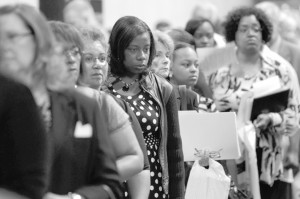The Black unemployment rate is double what whites experience
21st November 2016 · 0 Comments
By Freddie Allen
Contributing Writer
(NNPA Newswire) – Black workers lost ground last month, as the unemployment rate increased from 8.3 percent in September to 8.6 percent in October, according to the latest jobs report from the Labor Department.
October was a bad month for Black workers, in general. Not only did the share of Black workers in the labor force slide, the share of Blacks who held jobs (employment-population ratio) also declined. The employment-population ratio for Blacks decreased from 56.8 percent in September to 56.5 percent in October.
The white unemployment rate improved slightly from the 4.4 percent mark set in September to 4.3 percent in October. The labor force participation rate for white workers ticked down from 62.9 percent in September to 62.8 percent in October. The employment-population ratio slipped from September’s 60.2 percent to 60.1 percent in October.
Among adults 20 years and older, Black men suffered the biggest setback in October. The unemployment rate for Black men jumped from 8.2 percent in September to 8.7 percent in October. The participation rate for Black men remained unchanged from September to October (67.5 percent) and the employment-population ratio also decreased from 62 percent in September to 61.7 percent in October.
The jobless rate for white men hasn’t changed since July (4.1 percent) and the share of white male workers that were employed (69 percent) hasn’t changed since August. The labor force participation rate decreased from 72 percent in September to 71.9 percent in October.
The jobless rate for Black women over 20 years-old ticked up from seven percent in September to 7.1 percent in October. The labor force participation rate for Black women remained at 62.3 percent the same mark set in September, but the employment-population ratio weakened slightly edging down from 58 percent in September to 57.9 percent in October.
Last month, the unemployment rate for white women was the lowest of all adult working groups at 3.8 percent, but the participation rate for white women took a step down from 57.5 percent in September to 57.4 percent in October. The employment-population ratio for white women was 55.3 percent, the same mark set in September.
Elise Gould, a senior economist at the Economic Policy Institute, said that there was some good news in October’s jobs report noting that the economy added 161,000 new jobs and that “nominal wage growth increased 2.8 percent over the year” which could indicate that workers are starting to gain some leverage in the labor market.
The national unemployment rate improved from 5 percent in September to 4.9 percent in October. The healthcare sector added 31,000 jobs in October and 415,000 jobs over the past 12 months, according to the Labor Department.
“The economy continues to move in the right direction, but considerable slack remains and the recovery has yet to be fully realized in all parts of the economy or for all workers,” said Gould.
Rep. Bobby Scott (D-Va.) agreed.
“While we celebrate this progress, we also remain committed to making meaningful investments in our nation’s families and in our economy to ensure that our growing prosperity is broadly shared,” said Scott.
“There is no doubt we have made great economic strides under the Obama Administration, but we must build on this progress. There is more work to do to ensure that we build an economy that works for every family in America,” said Scott. “That’s why Committee Democrats continue to fight for the Working Families Agenda so we can boost wages, help people better balance work and family life, and level the playing field by ending discrimination in the workplace.”
This article originally published in the November 21, 2016 print edition of The Louisiana Weekly newspaper.



